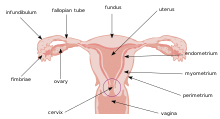
Cervical effacement or cervical ripening refers to the thinning and shortening of the cervix. This process occurs during labor to prepare the cervix for dilation to allow the fetus to pass through the vagina. While this is a normal, physiological process that occurs at the later end of pregnancy, it can also be induced through medications and procedures.[2]
During gestation, the cervix maintains pregnancy by increasing synthesis of various proteins. These proteins have defined interactions that allow the formation of matrix proteins to help fortify the uterine cervix.[3] Toward the end of pregnancy, a series of hormone-mediated biochemical process takes place to degrade the collagen and fiber network to cause the cervix to ripen during labor. Failure to ripen the cervix during labor may delay its onset and cause complications.[4] Current efforts to induce labor include pharmacologic, non-pharmacologic, mechanical and surgical methods.
Cervical ripening has primarily been performed in the inpatient setting. Due to a variety of reasons, such as cost and patient preference, the capacity to undergo outpatient cervical ripening is being explored.[5]
- ^ Prendiville W, Sankaranarayanan R (2017). "Anatomy of the uterine cervix and the transformation zone". Colposcopy and Treatment of Cervical Precancer. International Agency for Research on Cancer. Retrieved 2023-07-31.
- ^ McDonagh M, Skelly AC, Tilden E, Brodt ED, Dana T, Hart E, et al. (2021). "Outpatient Cervical Ripening: A Systematic Review and Meta-analysis". Obstetrics and Gynecology. 137 (6): 1091–1101. doi:10.1097/AOG.0000000000004382. PMC 8011513. PMID 33752219.
- ^ Winkler M, Rath W (1999). "Changes in the cervical extracellular matrix during pregnancy and parturition". Journal of Perinatal Medicine. 27 (1): 45–60. doi:10.1515/JPM.1999.006. PMID 10343934. S2CID 25915432.
- ^ Hayashi RH (1993). "Spontaneous and induced cervical ripening. Natural dilation and effacement process and current cervical ripening techniques". The Journal of Reproductive Medicine. 38 (1 Suppl): 66–72. PMID 8429529.
- ^ McDonagh M, Skelly AC, Hermesch A, et al. Cervical Ripening in the Outpatient Setting [Internet]. Rockville (MD): Agency for Healthcare Research and Quality (US); 2021 Mar. (Comparative Effectiveness Review, No. 238.) Introduction. Available from: https://www.ncbi.nlm.nih.gov/books/NBK569286/